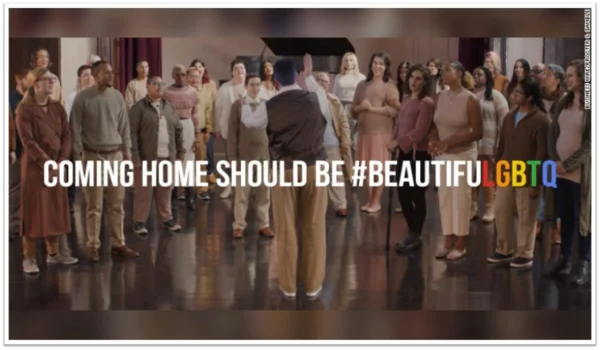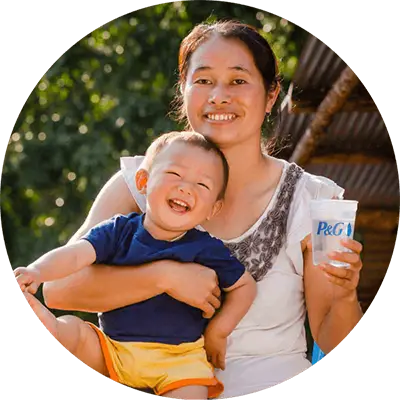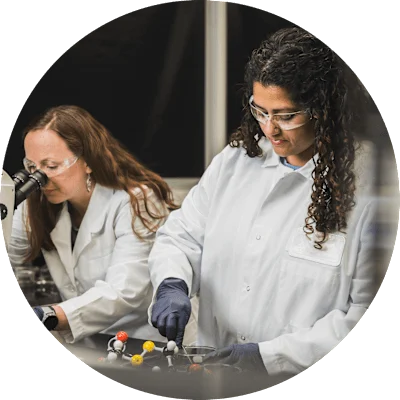5/28/2020
P&G and GLAAD’s New Study Reveals the Power of LGBTQ+ Inclusion in Advertising

At P&G, we have the opportunity to use our voice to address bias and create productive conversations. This commitment to using our reach as a force for good and a force for growth rings especially true as we prepare to celebrate Pride Month during a particularly challenging moment in history when the concepts of visibility, understanding, normalization, and shared humanity are more important than ever.
P&G has long been a champion of LGBTQ+ visibility that accurately and authentically portrays sexual orientation, gender identity and expression, but in order to ensure our advertising has a positive impact on our communities, P&G partnered with GLAAD to study the impact of LGBTQ+ inclusion in marketing and media.
The “LGBTQ+ Inclusion in Advertising and Media” study details how non-LGBTQ+ Americans respond to TV, films, and ads featuring LGBTQ+ representation. Findings from the study revealed high comfortability around viewing LGBTQ+ images in the media, favorability towards brands with LGBTQ+-inclusive advertising, and that inclusive media images lead to greater acceptance and understanding.
The study was conducted online among a national sample of more than two thousand non-LGBTQ+ U.S. adults using a sample sourced by research firm Cint. The findings from the study demonstrated that non-LGBTQ+ Americans who had been exposed to LGBTQ+ people in media were more likely to accept LGBTQ+ people and be supportive of LGBTQ+ issues in comparison to respondents who had not been exposed to LGBTQ+ people in the media.
- 48% of respondents who had been exposed to LGBTQ+ people in the media say they are more accepting of gay and lesbian people over the past few years when compared to the respondents who had not recently seen LGBTQ+ people in the media (35%).
- 45% of respondents who had been exposed to LGBTQ+ people in the media say they are more accepting of bisexual people over the past few years when compared to the respondents who had not recently seen LGBTQ+ people in the media (31%).
- 41% of respondents who had been exposed to LGBTQ+ people in the media say they are more accepting of non-binary people over the past few years when compared to the respondents who had not recently seen LGBTQ+ people in the media (30%).
- 80% of respondents who had been exposed to LGBTQ+ people in the media say they are more supportive of equal rights for LGBTQ+ people when compared to the respondents who had not recently seen LGBTQ+ people in the media (70%).
The study found that non-LGBTQ+ consumers exposed to LGBTQ+ people in the media had higher levels of comfortability with LGBTQ+ people in their daily lives.
- 72% of respondents who had been exposed to LGBTQ+ people in the media were more likely to be comfortable learning a family member was LGBTQ+, compared to those who had not (66%).
- 79% of respondents who had been exposed to LGBTQ+ people in the media were more likely to be comfortable having a new LGBTQ+ family with children move into their neighborhood when compared to respondents who had not (72%).
- 69% of respondents who had been exposed to LGBTQ+ people in the media were more likely to be comfortable starting a conversation with people whose gender is unclear when compared to respondents who had not (60%).
- 81% of respondents who had been exposed to LGBTQ+ people in the media were more likely to be comfortable starting a conversation with people whose sexual orientation is different than their own when compared to respondents who had not (76%).
- 73% of respondents who had been exposed to LGBTQ+ people in the media were more likely to be comfortable learning their doctor is gay, lesbian or bisexual when compared to respondents who had not (67%).
Respondents also looked favorably upon companies who included LGBTQ+ people in their advertisements.
- 86% of respondents believe it reflects the company’s support of LGBTQ+ rights.
- 85% of respondents believe it reflects the company’s commitment to offering products to all types of customers.
- 82% of respondents believe that it reflects the company’s value for all kinds of diversity.
- 80% of respondents believe that it reflects that the company is making a statement about the importance of recognizing LGBTQ+ people.
“During the COVID-19 epidemic, when media consumption is up and when media outlets serve as lifelines for LGBTQ+ people in isolation, companies should recognize that now is the right time to grow the quality and quantity of LGBTQ+ people in advertising,” said GLAAD President & CEO Sarah Kate Ellis. “Significant work still needs to be done given the history of bias in LGBTQ representation, but leaders like P&G are raising the bar and bringing other powerful brands to the table.”
While the findings from the study demonstrate positive progress, there is still significant work that needs to be done in order to ensure that companies and brands are including LGBTQ+ people in their ads and marketing to the LGBTQ+ community in authentic, positive and impactful ways.
In response to these critical gaps, GLAAD, P&G, and the Association of National Advertisers’ Alliance for Inclusive and Multicultural Marketing (AIMM) announced plans to develop best in class practices and standards for LGBTQ+ inclusion in advertising and marketing. The best practices developed through this partnership will create accountability across the industry and become a fundamental blueprint for LGBTQ+ inclusion in advertising that ensures brands and companies prioritize impact, as well as accurate and authentic representation.
“It’s important that we engage more deeply with partners like GLAAD, the ANA/AIMM and others to develop best-in-class practices for LGBTQ+ inclusion,” said P&G Chief Brand Officer Marc Pritchard. “The community faces challenging obstacles and it’s my hope that this work will allow everyone in our industry to come together and use our collective voice for good – to drive acceptance, inclusion and love for humanity.”
P&G will further demonstrate the power of LGBTQ+ visibility in advertising with the release of its new film, “They Will See You,” a new film from P&G and CNN’s Great Big Story launching May 28. It showcases the impact that inclusion can have on local communities and how global brands can increase the visibility of marginalized people everywhere. “They Will See You” is the third in the series following last year’s “Out of the Shadows” and 2018’s “The Words Matter.”
Throughout our journey, P&G hasn’t gotten everything right, but we look forward to continuing to learn, explore and understand the uniqueness of all of our employees and consumers alongside our brands and partners.
Learn more about the study here.


